A cachette is a group of objects that are hidden for safekeeping. The 21st Dynasty (1077 BC-943 BC) was a time of political instability, so the royal burials of the New Kingdom (c. 1550 BC–c. 1069 BC) in the Valley of the Kings on the west bank of the Nile opposite Luxor were robbed.
In order to protect the royal remains, the priests of the god Amun of Thebes systematically entered each royal tomb to collect the bodies and any remaining artefacts. They unwrapped the mummies, removed jewellery and amulets, then carefully rewrapped and labelled the deceased before concealing them in a tomb cut in the cliffs of Deir el Bahari (tomb DB320) on the West Bank of Luxor.
The family of someone called Abdel el-Rassul first discovered this cache in the 19th century, kept it secret, and removed artefacts to sell on the antiquities market.
As several of these objects were inscribed with royal names, they came to the attention of the antiquities authorities at that time. An investigation was launched. In July 1881, the authorities cleared the tomb and loaded the 40 royal and non-royal mummies, along with artefacts belonging to 54 different individuals, onto a steamer bound for Cairo for display at the Egyptian Museum.
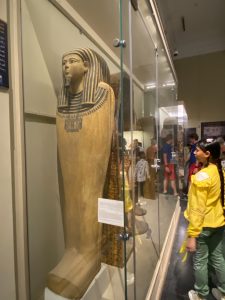
In 2021, the mummies and most of the coffins were transferred to the National Museum of Egyptian Civilisation in the Pharaohs’ Golden Parade. Some coffins can still be seen at the Egyptian Museum (also known as the Cairo Museum) in Tahrir.
The United States Ambassadors’ Fund for Cultural Preservation finances the survey and documentation of 626 wooden coffins, emergency conservation of deteriorated coffins, upgrades of storage areas, and equipment for inventorying the pharaonic antiquities.
On the museum’s first floor, there is a hall labelled ‘Cachettes: Hidden treasures’.
The first item visitors see in the cedar-wood coffin of King Ahmose I, founder of the 18th Dynasty (1550/1549-1292 BC) of the New Kingdom. His coffin was originally decorated with a feathered pattern and covered with gold foil, inlaid with semi-precious stones. These were removed by ancient robbers and replaced with yellow and blue paint when the coffin was restored and reburied in DB 320 in the 8th year of the 21st dynasty high priest and King Pinedjem I. The redecorated lid of the coffin has a pectoral plaque with the cartouches of the king and a figure of Egypt’s state god, Amun-Ra. The interior is undecorated.
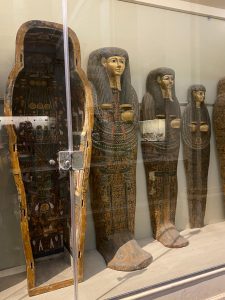
Also on display is the coffin set of Neskhons, daughter of king Smendes, who founded the 21st Dynasty. She was a priestess at Karnak and the King’s Daughter of Kush. Ancient robbers ripped off the gold-covered face, breasts, and hands off the inner coffin and mummy board. The djed pillar of Osiris is inside the outer coffin. The winged goddess of the west embraces the deceased from above and below inside the inner coffin. The goddess Isis holds the ankh, the key of life, over the mummy inside the mummy board.
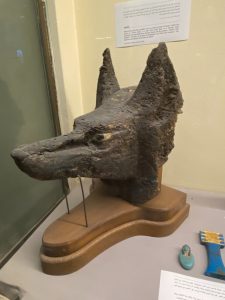
The head of the god Anubis was probably worn as a mask by priests of Anubis, who was shown as a black canine, or a man with a canine head. As a funerary deity, associated with mummification, funerary rituals, and the cemetery, Anubis’s titles included: “He who is in the place of embalming” and “God of the cemetery”. The eyebrows and whiskers on the mask are gilded.
The small gilded-wood statue of the ‘Ba’ bird was another aspect of the soul, represented by a human-headed bird. The ‘ba’ can roam freely when the person is dying.
A glass scarab on a gilded wooden base reads: “Do not say any bad thing against me before Osiris, the great god of the dead”. It is a spell from chapter 30 of the Book of the Dead that asks the deceased’s heart to be silent during the judgement. This spell is written on the back of the amulet that was placed next to the mummy’s heart or within its wrappings.
The ancient Egyptians considered the heart the most important part of the human body because it was the centre of feeling and conscience. The heart was weighed against the feather of goddess of Justice Maat.
 A duck- or goose-shaped box might have contained a bird that had been prepared for eating and then wrapped in linen, ready to be unwrapped and enjoyed by the deceased in the afterworld. Food was crucial to life, and therefore food offerings were an important component of the tomb assemblage.
A duck- or goose-shaped box might have contained a bird that had been prepared for eating and then wrapped in linen, ready to be unwrapped and enjoyed by the deceased in the afterworld. Food was crucial to life, and therefore food offerings were an important component of the tomb assemblage.
The painted-wood inner coffin and mummy board of Meritamun, Chantress of Amun, daughter of the High Priest of Amun is also on display.
The coffin, in the form of Meritamun, is decorated with religious texts and images showing deities and the judgement of the dead. The mummy board shows Meritamun wearing a long, half-sleeved robe and a wig decorated with flowers with one hand on her chest and the other alongside her body.
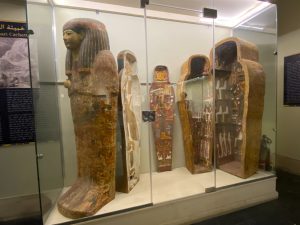



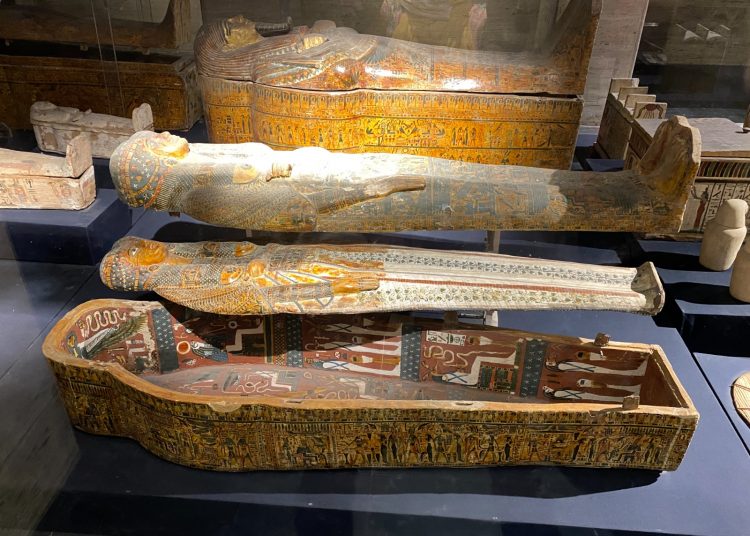
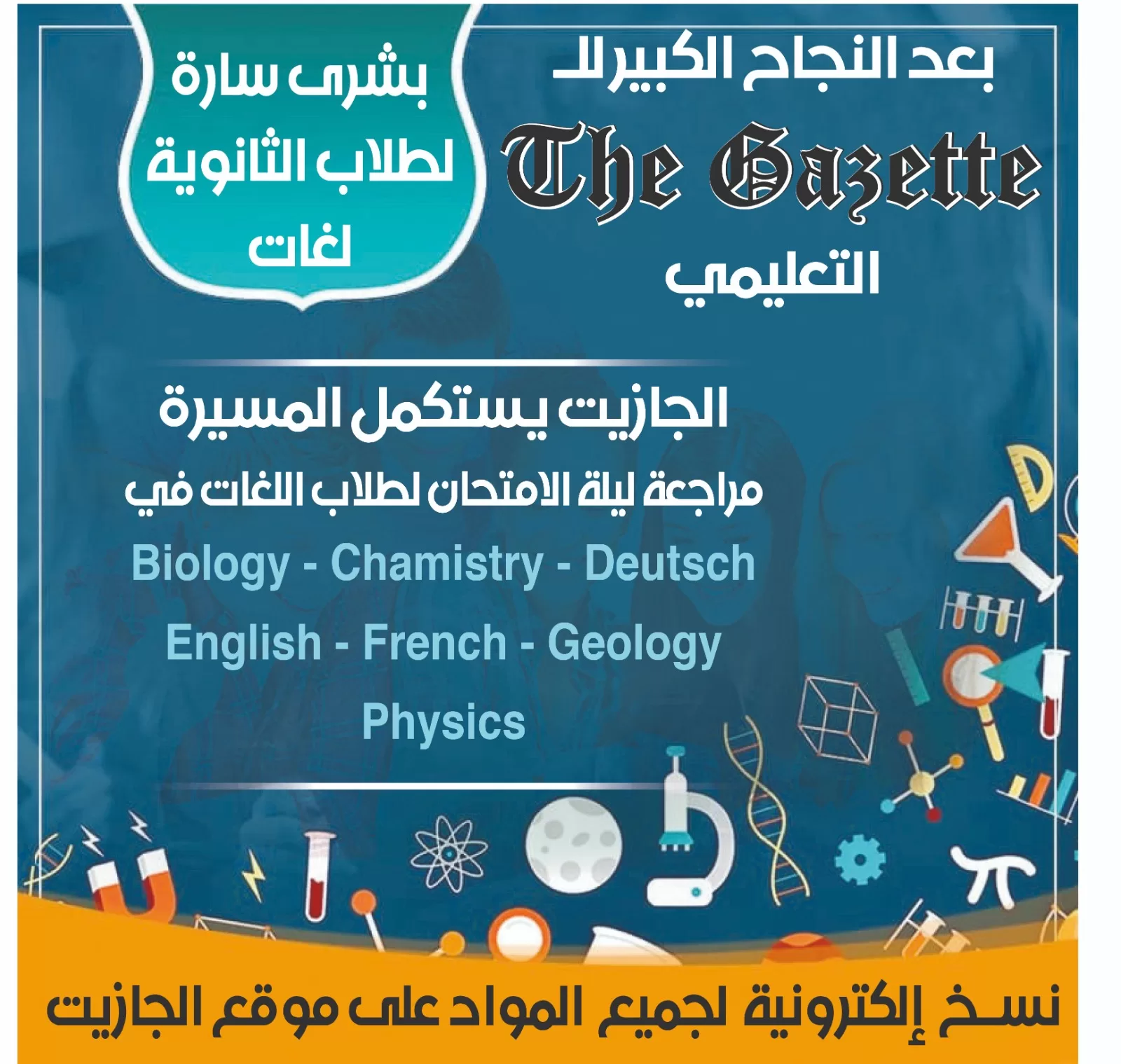

Discussion about this post